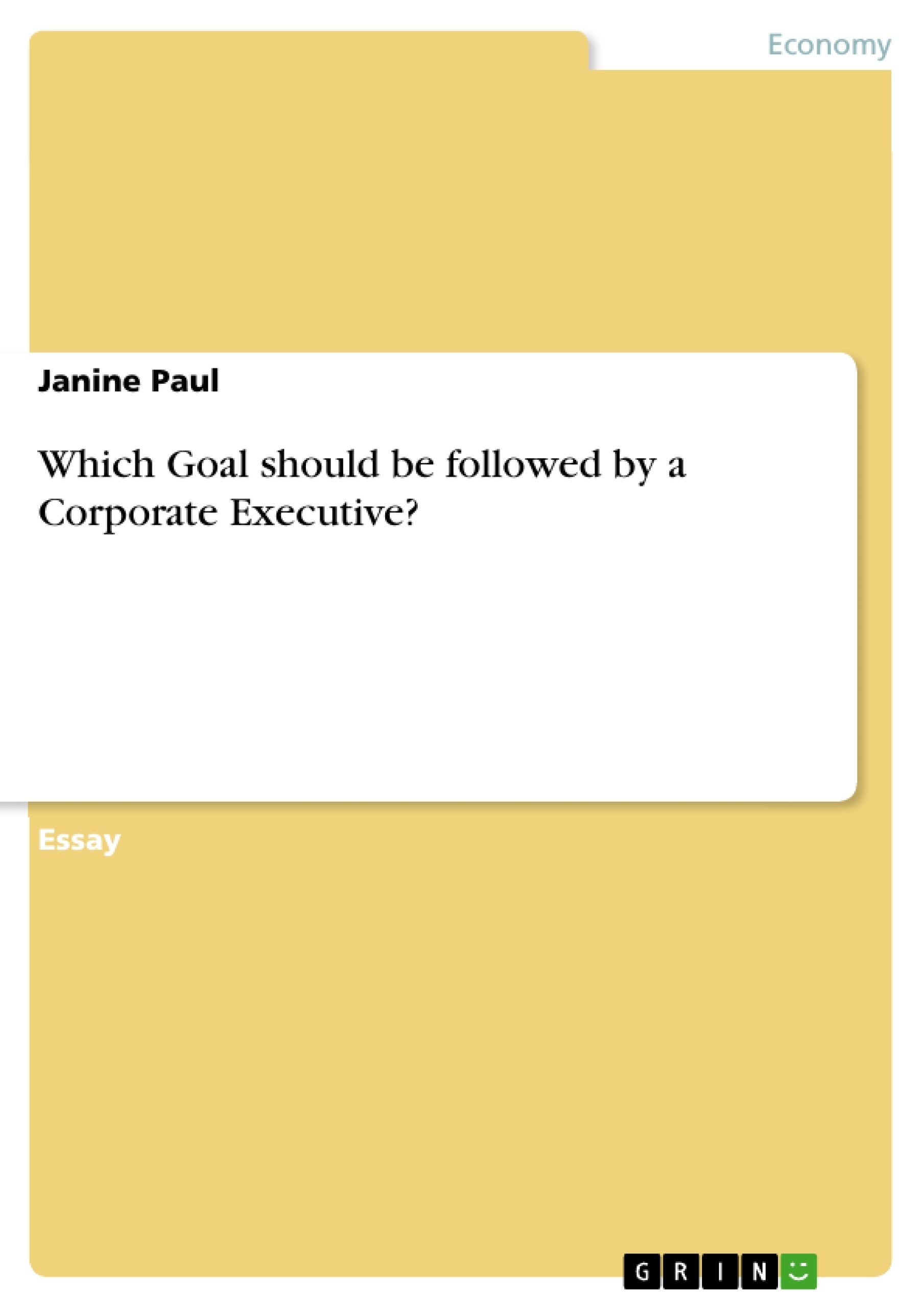Extrait
Table of Contents
1 Introduction
2 Discussion
2.1 Shareholder wealth maximisation
2.2 Profit maximisation
2.3 Sales maximisation
2.4 Social Responsibility
2.5 Survival
3 Conclusion
4 References
5 Bibliography
6 Appendices
1 Introduction
A corporate chief executive encompasses the final responsibility for a successful company development. “He sets the objectives for the business and specifies strategies for their achievement” (Lines, 1978:3). Further key tasks are listed in Appendix A. In this unique role he is also responsible for the funding of the business (Lines, 1978). Since 1st December 2007 Andrew Harrison is the chief executive of easyJet (easyJet plc, 2007). He defines the organisational structure to lead staff towards defined goals (Mullins, 1999). easy Jets organisation structure is a flat management structure. A comparison of flat and tall management structures is given in Appendix B.
Being under the pressure of different interest groups the question arises which interest should be given priority? Easy Jet postulates “creating real wealth for all stakeholders“ (Bournemouth University, 2004: 22). This assignment demonstrates the theory and understanding of the five objectives. Discussing their importance and priorities, a link is given to easyJet plc.
2 Discussion
2.1 Shareholder wealth maximisation
Wealth in this context means “the market value of ordinary shares.” This value states the future potential return for a shareholder’s investment in relation to the risk taken over a certain time period (Atrill, 2000: 5). They can benefit from the company in form of dividends and/or through increases in the share value from the point of buying (Neale & McElroy, 2004). “Shareholder will weigh the returns from each investment against the potential risk involved” (Atrill, 2000:7). Banks are seen as safe but usually bring lower return on investment (Atrill, 2007).
The common opinion of authors is that shareholder wealth maximisation is the answer to the question raised in the introduction. It is “…the driving force behind […] strategic and operational decisions” (Atrill & McLaney 2006: 352). Other objectives are seen as subordinate (Watson & Head, 2007: 8). Neale & McElroy (2004:10) see it as a company’s responsibility to maximising returns for shareholders as they are the owner. Moreover, globalisation created competition for funds of shareholders. Therefore the focus has to be on their interests to reach their financial support (Atrill & McLaney 2006). However, this objective seems to follow only the interest of one stakeholder “…perhaps at the expense of the others” (McLaney 2004:18). Van Horne et al. (2005) support that only through consideration of various stakeholders the final goal of wealth maximisation can be reached.
Sir Colin Chandler, eastJets’ Chairman said:
“this year’s performance is aligned with our targets and underpins the delivery of improved returns to shareholders. We remain focused on improving our return on equity” (easyJet plc, 2006a).
This demonstrates that easyJet’s primary goal is maximising shareholder wealth. It decided not to pay dividends “...instead it ploughs every penny of profit into buying more planes” (easyJet plc, 2006a; thelondonpaper, 2007). The mentioned development of return on equity is apparent in Table 2.1. The five-year-performance of equity confirms the chairman’s intentions.
Table 2.1 - Return on equity
illustration not visible in this excerpt
easyJet plc, 2006a
Figure 2.1 shows the development of the share price over the last 6 months indicating a rise from £4.76 September 2006 to £ 6.61 March 2007. This increase of 38.9% means the reach of shareholder wealth maximisation.
illustration not visible in this excerpt
Figure 2.1 – EasyJet’s share price performance
Source: Finanztreff.de, 2007
2.2 Profit maximisation
“Profit maximisation is achieved at a level where marginal costs and marginal revenue are equal” (Watts, 1997: 119):
Profit = total sales of revenue – total costs
The break even point is “the level of operation […] at which a company neither earns a profit nor incurs a loss” (Zimmerer & Scarborough, 2005: 350). Beyond this point profits increase as activity increases (Atrill and McLaney, 2006) as visible in appendix C. This could take the form of
a) increasing the selling price of an item (other costs stay the same) (Watts, 1991)
b) decreasing the cost of production (Drury, 2005).
Appendix D gives an overview of factors influencing profit. Profits have no time dimension and also do not take risk into account. Therefore high profits do not necessarily indicate a healthy performance of the business as profits may be used to pay bank loans or other debts (Watson & Head, 2007).
Atrill (2000: 6) sees “profit maximisation […] as an alternative objective for a business”. However, it does not achieve the objective of the firm’s owners, it should therefore not be the primary goal of financial managers (Gitman, 2006). This is supported Pike & Neale (2003) saying that shareholder wealth is preferred to profit maximisation. Finally, this objective does not exclude shareholder wealth maximisation: If (higher) profits are made (higher) dividends can be paid to shareholders if not invested somewhere else. The profit objective can even lead to the maximisation of the overall welfare “by doing the best for yourself, you are unconsciously doing the best for society” (Drury 2005: 8).
Table 2.1 – easyJet’s profit performance
illustration not visible in this excerpt
EasyJet plc, 2006b
[...]
- Citation du texte
- Janine Paul (Auteur), 2007, Which Goal should be followed by a Corporate Executive?, Munich, GRIN Verlag, https://www.grin.com/document/92274
Devenir un auteur






















Commentaires